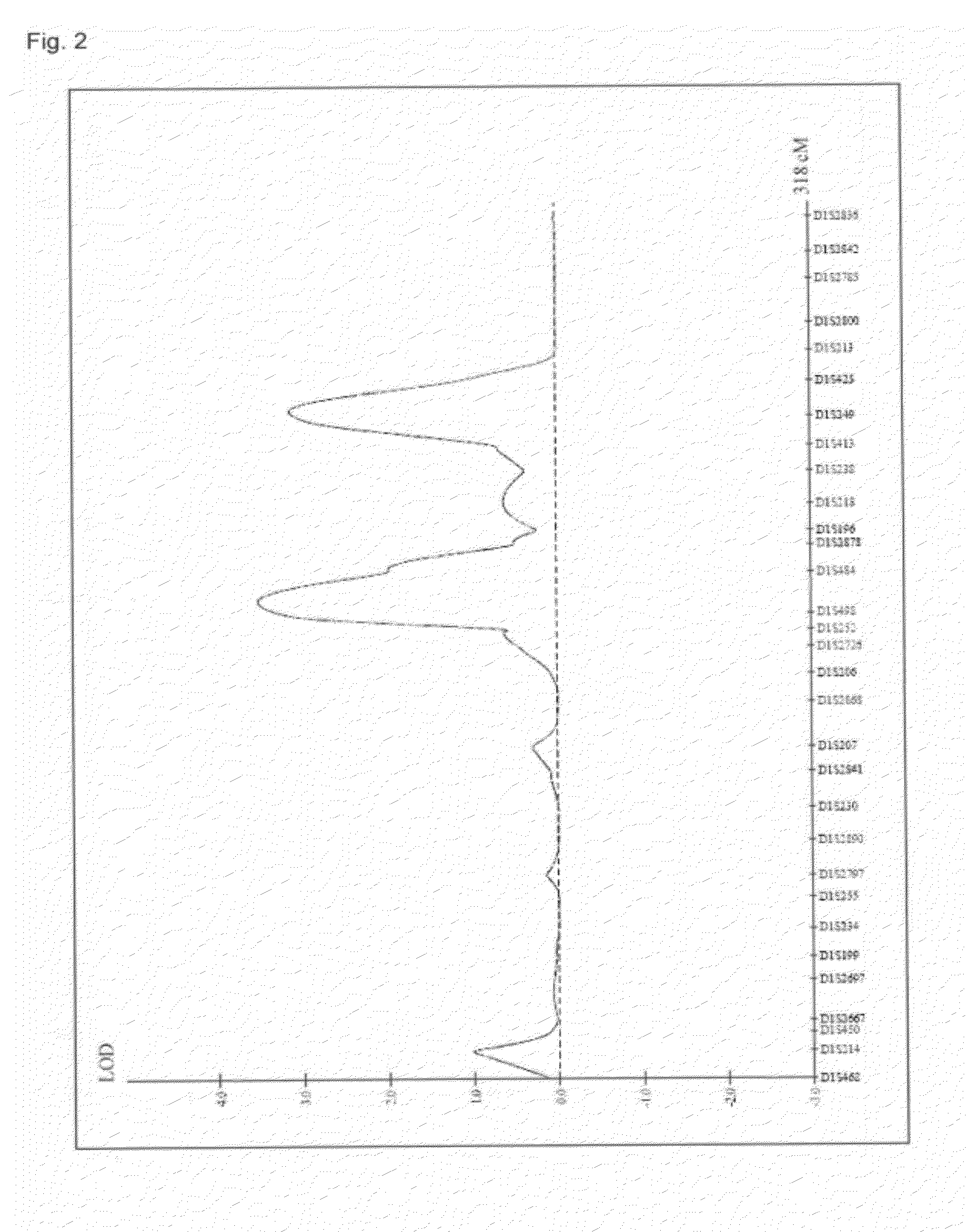Hair Shape Susceptibility Gene
a susceptibility gene and hair technology, applied in the field of hair shape susceptibility genes, can solve the problems of hairstyle freedom, hair cannot be volumized, hair cannot be shaped,
- Summary
- Abstract
- Description
- Claims
- Application Information
AI Technical Summary
Benefits of technology
Problems solved by technology
Method used
Image
Examples
example 1
Definition of Hair Shape and Collection of Curly Hair Family Lines
[0405]In the present Example, an affected sib-pair linkage analysis and a case-control association analysis were carried out on a Japanese group, in order to identify the hair shape susceptibility gene.
[0406]In general, hair shape varies with the human race, and the people of the Asian race relatively more frequently have straight hair, while the people of the African race mainly have kinky hair (or curled hair). A large proportion of the people of the Indo-European race have a trait of wavy hair (wave hair) which is intermediate of the two. Since a Japanese group is a straight hair-dominant group, people having a curly hair trait as the hair shape were defined as the affected (case), while the straight hair trait was defined as the control (control). In a genetic analysis such as a linkage analysis, it is necessary to handle the object traits quantitatively to a certain extent, and thus, for example, a method of bina...
example 2
Affected Sib-Pair Linkage Analysis on Entire Genome
[0412]In the present Example, an affected sib-pair linkage analysis covering the entire genome was carried out for the first time on the Japanese curly hair family lines. To briefly describe the principle of this method, since siblings that are affected have inherited from their parents an allele causative of a disease, the siblings necessarily share the allele. On the other hand, the number of alleles shared by brothers is 1 (a value based on the null hypothesis). When many cases of allele sharing could be observed from the number of alleles based on the null hypothesis by examining the number of alleles shared by many affected sib-pairs, it was determined that linkage was recognized.
[0413]The affected sib-pair linkage analysis was carried out using a linkage mapping set (ABI PRISM Linkage Mapping Set-MD 10 v2.5) manufactured by Applied Biosystems, Inc. (ABI). This is a set of 400 fluorescent primers for typing in total, intended t...
example 3
Detailed Mapping in Candidate Regions
[0419]Subsequently, chromosome 1 where linkages was recognized in Example 2 was subjected to an affected sib-pair linkage analysis (detailed mapping) by further using microsatellite markers, for the purpose of narrowing the linkage regions.
[0420]The microsatellites used as a marker for the detailed mapping were searched using Comprehensive human genetic maps of the Mammalian Genotyping Service (http: / / research.marshfieldclinic.org / genetics / GeneticResearch / compMaps.asp). Microsatellites which were present in the genome at an interval of 1 to 2 cM and had high heterozygosity were selected. Furthermore, the fluorescent primers for typing, which were intended to amplify the microsatellites, were designed based on the Genome Database Project (GDB) (http: / / www.gdb.org / ). Here, although the GDB has terminated the operation, currently retrieval and design can be carried out through the NCBI (http: / / www.ncbi.nlm.nih.gov / ). Fluorescent primers for typing m...
PUM
| Property | Measurement | Unit |
|---|---|---|
| degree of freedom | aaaaa | aaaaa |
| temperature | aaaaa | aaaaa |
| concentration | aaaaa | aaaaa |
Abstract
Description
Claims
Application Information
 Login to View More
Login to View More - R&D
- Intellectual Property
- Life Sciences
- Materials
- Tech Scout
- Unparalleled Data Quality
- Higher Quality Content
- 60% Fewer Hallucinations
Browse by: Latest US Patents, China's latest patents, Technical Efficacy Thesaurus, Application Domain, Technology Topic, Popular Technical Reports.
© 2025 PatSnap. All rights reserved.Legal|Privacy policy|Modern Slavery Act Transparency Statement|Sitemap|About US| Contact US: help@patsnap.com



